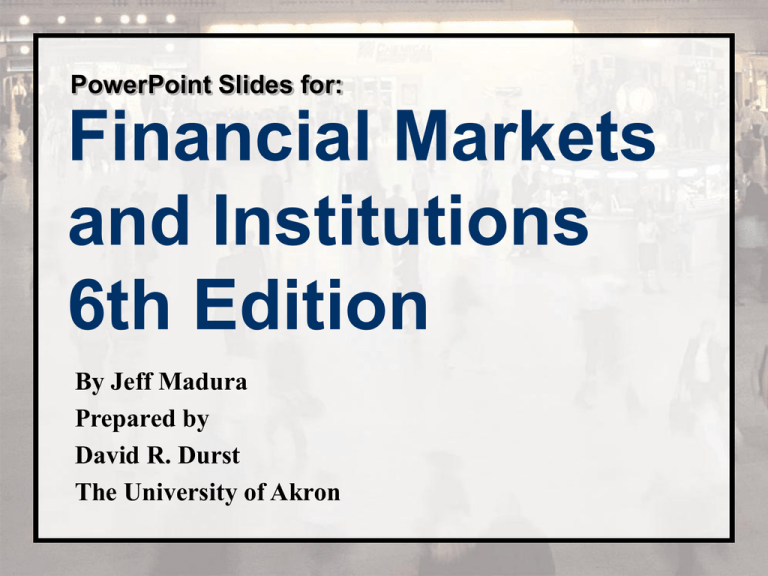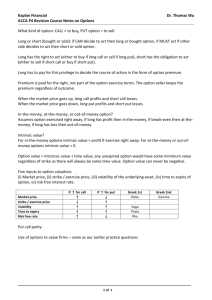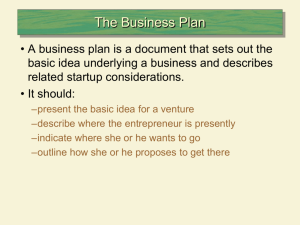
PowerPoint Slides for:
Financial Markets
and Institutions
6th Edition
By Jeff Madura
Prepared by
David R. Durst
The University of Akron
CHAPTER
14
Options
Markets
Chapter Objectives
Explain how stock options are used to
speculate
Explain why stock option premiums vary
Explain how options are used by financial
institutions to hedge their security portfolios
Copyright© 2002 Thomson Publishing. All rights reserved.
Stock Options
An option contract grants the buyer, who has
paid a premium to the seller (writer), the right
to buy or sell the underlying asset at a stated
price within a specific period of time
The premium paid to the writer is the cost of
the option
Buyer has the “option,” but not the obligation,
to exercise the option
Copyright© 2002 Thomson Publishing. All rights reserved.
Background on Options
A call option buyer has right but not the
obligation to buy the underlying asset at a set
exercise or “strike” price for a specified period
of time
A put option buyer has the right but not the
obligation to sell the underlying asset at a set
“strike” price for a specified period of time
Note components of an option: specific
quantity of asset, price, and time period
Copyright© 2002 Thomson Publishing. All rights reserved.
Background on Options
Premium is the price the buyer of the put or
call pays to buy an option contract
Seller or writer of the option contract
Receives the premium up front
Has an ongoing obligation to sell (call) or buy
(put) if the buyer decides to exercise the option
contract
Current market price of the underlying asset or
financial instrument is called the spot price
Copyright© 2002 Thomson Publishing. All rights reserved.
Background on Options
Call options
“In-the-money” means the call option’s strike or
exercise price is lower than the market price for
the underlying financial instrument
The
holder of the call can buy the stock at a price below
the current market price
The call premium (price) of the option would also be
higher by the “in-the-money”
At-the-money means the strike price equals the
market price of the underlying asset
Copyright© 2002 Thomson Publishing. All rights reserved.
Background on Options
Put option
In-the-money means the put option’s strike or
exercise price is higher than the market price for
the underlying financial instrument
Put options give the investor an opportunity to
make money from falling prices
Investor has locked in a sale price, making the
price of the option (premium) higher as the stock
price decreases
At-the-money means the strike price equals the
market price of the underlying asset
Copyright© 2002 Thomson Publishing. All rights reserved.
Background on Options
Expiration is the date when the contract
matures
American-style options contracts can be
exercised any time up until they expire
European-style options can only be exercised
just before their expiration
Option contracts guaranteed by a
clearinghouse to make sure sellers or writers
fulfill their obligations
Stock options specify 100 shares of stock
Copyright© 2002 Thomson Publishing. All rights reserved.
Stock Option Quotations
Options quotations available in the financial
press and on the Internet
Typically more than one option contract for a
company’s stock
Many contracts trade for the same stock but with
different strike prices and expiration dates
Quotes indicate the volume, premium, strike price
and maturity
Copyright© 2002 Thomson Publishing. All rights reserved.
Exhibit 14.1 McDonald’s Stock Option
Quotations
McDonald’s
Strike
Exp.
Vol.
Call
Vol.
Put
45
Jun
180
4½
60
2¾
45
Oct
70
5¾
1 20
3¾
50
Jun
360
11/8
40
51/8
50
Oct
90
3½
40
6½
Copyright© 2002 Thomson Publishing. All rights reserved.
Speculating with Call Options
BUY A CALL: Speculator thinks a stock price will
appreciate above a particular strike price
Buyer of call pays premium for the right but not the
obligation to buy stock at the strike price
If the stock price appreciates above the strike price
the option contract is in-the-money and buyer of the
call would exercise or sell the option at a price
including the “in-the-money” and a premium
If the stock price does not appreciate, buyer of the
call does not exercise and losses are limited to the
cost of the premium—buyer able to share in
appreciation without large investment
Copyright© 2002 Thomson Publishing. All rights reserved.
Speculating with Call Options
If stock price rises above call’s strike price,
buyer exercises and purchases shares at a price
below their current market price
Breakeven occurs once stock price is high
enough above strike to cover premium’s cost
Net gain or loss equals
+ Price received for selling stock (spot price)
- Amount paid for the shares (call’s strike)
- Amount of the premium
Copyright© 2002 Thomson Publishing. All rights reserved.
Speculating with Call Options
Breakeven = Strike + Premium
Call
Buyer
+
0
Call
Writer
Strike Price
Copyright© 2002 Thomson Publishing. All rights reserved.
Speculating with Put Options
BUY A PUT: Speculator thinks a stock price will
depreciate below a particular strike price
Buyer of put pays premium for the right but not the
obligation to sell stock at the strike price
If the stock price depreciates below the strike price
the option contract is in-the-money and buyer of the
put would exercise
If the stock price does not depreciate, buyer of the
put does not exercise and losses are limited to the
cost of the premium
Copyright© 2002 Thomson Publishing. All rights reserved.
Speculating with Put Options
If stock price falls below strike, buyer of a put
exercises and sells shares at a price above their
current market price
Breakeven occurs once stock price is low
enough below strike to cover premium’s cost
Net gain or loss equals
+Price received for selling stock (strike price)
- Amount paid for the shares (spot market)
- Amount of the premium
Copyright© 2002 Thomson Publishing. All rights reserved.
Speculating with Put Options
Breakeven = Strike - Premium
+
Put Seller
0
Put Buyer
Strike Price or At-The-Money
Copyright© 2002 Thomson Publishing. All rights reserved.
Determinants of Call Option Premiums
Value of Call Option
Premium
Volatility of the
Underlying Asset
Market Price of the
Underlying Asset
Time to Maturity of the
Option Contract
Copyright© 2002 Thomson Publishing. All rights reserved.
Determinants of Call Option Premiums
The greater the current market price of the
underlying asset compared to the exercise
price, the higher the premium for a call option
As the market price of the underlying asset
approaches or moves above the strike price, there
is increased chance of continued price
appreciation and increased gain from the option
Purchaser is willing to pay more for the option
“Under Water” option has less chance of being
“in-the-money” and the premium is less
Copyright© 2002 Thomson Publishing. All rights reserved.
Determinants of Call Option Premiums
Greater volatility of the underlying financial
asset means higher call option premiums
Volatile price means a higher chance price will go
well above strike
That chance makes buyers willing to pay more
For a call, the longer the time to maturity, the
higher the premium
Owner will have increased chance for the option
to be “in-the-money” with more time available
Copyright© 2002 Thomson Publishing. All rights reserved.
Determinants of Put Option Premiums
The lower the current market price of the
underlying asset compared to the exercise
price, the higher the premium for a put option
Better chance of price depreciation well below
strike price if the price of the underlying asset is
already close to or below the exercise price
Stock price appreciation reduces premium as
chance of “in-the-money” decreases
Volatility and maturity issues the same as for
call options
Copyright© 2002 Thomson Publishing. All rights reserved.
Explaining Changes in Option Premiums
Indicators monitored by participants in the
options market
Premiums influenced by price movements of the
underlying stocks
Monitor economic indicators, industry-specific,
and firm-specific conditions
Speculative options positions limit the downside
risk (the cost of the premium) so options owners
may view some indicators differently
Copyright© 2002 Thomson Publishing. All rights reserved.
Exhibit 14.11 Stock Option Premium
Changes Over Time
International
Economic
Conditions
U.S.
Fiscal
Policy
U.S.
Monetary
Policy
Issuer’s
Industry
Conditions
U.S.
Economic
Conditions
Stock
Market
Conditions
U.S.
Risk-Free
Interest
Rate
Issuer’s
Risk
Premium
Market Risk
Premium
Expected
Cash Flows
Generated
by the Firm
for Investors
Required
Return on
the Stock
Option’s
Exercise
Price
Price
of Firm’s
Stock
Stock Price
Relative to
Option’s
Exercise
Price
Option’s
T ime
until
Expiration
Expected
Volatility of
Stock Prices
over the
Period Prior
to Option
Expiration
Stock Option’s
Premium
Copyright© 2002 Thomson Publishing. All rights reserved.
Hedging with Stock Options
Investor hedge against possible adverse stock
price movements
Downside price insurance for stock investor
Investor can sell/write a call or buy a put if
concerned about a temporary decline in a stock
price
Writer/seller gains premium income from
“covered” option to offset possible stock losses in
exchange for giving up possible upside profit
Buying a put trades premium for downside floor
on stock portfolio
Copyright© 2002 Thomson Publishing. All rights reserved.
Using Options to Measure a Stock’s Risk
Standard deviation is used to measure risk for
a stock
Stock option premiums commonly are used to
derive the market’s anticipation of a stock’s
standard deviation over the life of the option
Anticipated volatility of a stock is not
observable but the stock option formula can be
used to derive an estimate
Copyright© 2002 Thomson Publishing. All rights reserved.
Stock Index Options
Right to trade a specified stock index at a
specified price by a specified expiration date
Options on several indexes
S&P 100
Major Market Index
Value Line
National OTC index
NYSE composite
Copyright© 2002 Thomson Publishing. All rights reserved.
Stock Index Options
Hedging with stock index options
Pension funds and financial institutions that own
large portfolios of stocks
Buy stock index puts to lock in gain or hedge
downturns in the market
Select index option that matches portfolio
Hedging with long-term stock index futures
LEAPs or long-term equity anticipations
Expiration dates at least two years into the future,
longer than normal options
Copyright© 2002 Thomson Publishing. All rights reserved.
Stock Index Options
Dynamic asset allocation with stock index
options
As expectations change, switch between risky
and low-risk investment positions
Anticipating stock price increases, portfolio
managers purchase calls and increase their risk
exposure
Hedge if unfavorable conditions expected
Sell calls to insure against market declines
Copyright© 2002 Thomson Publishing. All rights reserved.
Stock Index Options
Using index options to measure the market’s
risk
Stock index’s implied volatility can be derived
from options
Over time standard deviation sometimes
abruptly changes
Review of historical events explain changes
Gulf War, stock market crashes, and global
economic and financial crisis
Copyright© 2002 Thomson Publishing. All rights reserved.
Options on Futures Contracts
Options on futures allow the right but not the
obligation to purchase or sell a particular
futures contract for a specified price and for a
specified period of time
Types of options on futures that are available
Stock index futures
Interest rate futures
Used for speculation and one-way hedging
Copyright© 2002 Thomson Publishing. All rights reserved.
Options on Futures Contracts
Speculating with options on futures if an interest rate
decline is anticipated
Purchase a call option on Treasury bond futures
If expectations are correct, T-bond prices and futures
contract increase as interest rate levels decrease
Exercise the option to purchase futures at the strike
price which is lower than the value of the futures
contract
Selling futures offsets futures position at a profit
Copyright© 2002 Thomson Publishing. All rights reserved.
Options on Futures Contracts
Speculating with options on futures
Advantages of using options on futures
Expectations are not always correct
If rates actually rise, speculator loses if in futures
contracts, but just the premium if in options
Loss is reduced using the options on futures
strategy as compared to a futures only speculative
position
If rates rise, do not exercise option on futures
Copyright© 2002 Thomson Publishing. All rights reserved.
Options on Futures Contracts
Risks of speculating with options on futures
Example in 1995 of Barings PLC
U.K. investment bank
$1 billion in losses from derivative positions
Lessons
Monitor derivative trading closely
Separate reporting from trading so losses are not
concealed
Recognize margin calls may signal problems
Copyright© 2002 Thomson Publishing. All rights reserved.
Hedging with Options on Futures
Used by financial institutions with long-term
mortgages funded by short-term liabilities so
the downside risk is from an interest rate
increase
Can use a strategy to gain from futures options if
rates actually increase, offsetting loss of interest
margin in the business
Prepayment risk on loans is important if the
institution loses its offsetting mortgage loans
Copyright© 2002 Thomson Publishing. All rights reserved.
Hedging with Options on Futures
A portfolio manager wishes to hedge the downside
risk(one-way insurance) of a stock portfolio while
allowing for the upside potential
Buy put options on futures to hedge a possible
temporary decline in the market
Can choose among strike prices available and decide
the degree of risk to hedge
Can sell call options to cover the cost of buying put
options
Widespread institutional uses of options
Copyright© 2002 Thomson Publishing. All rights reserved.
Globalization of Options Markets
Global stock market drives need for global
options market
Options exchanges exist in many countries
Currency options contracts
Options on foreign currencies
Speculate on changes in foreign exchange rates,
the underlying asset
Hedge risks caused by firm’s transactions
denominated in foreign currencies
Copyright© 2002 Thomson Publishing. All rights reserved.





